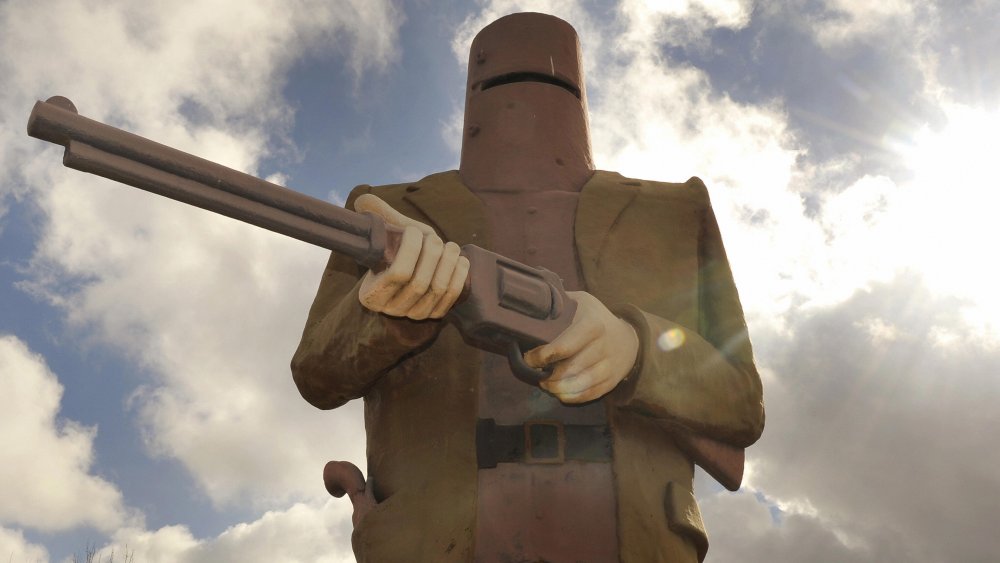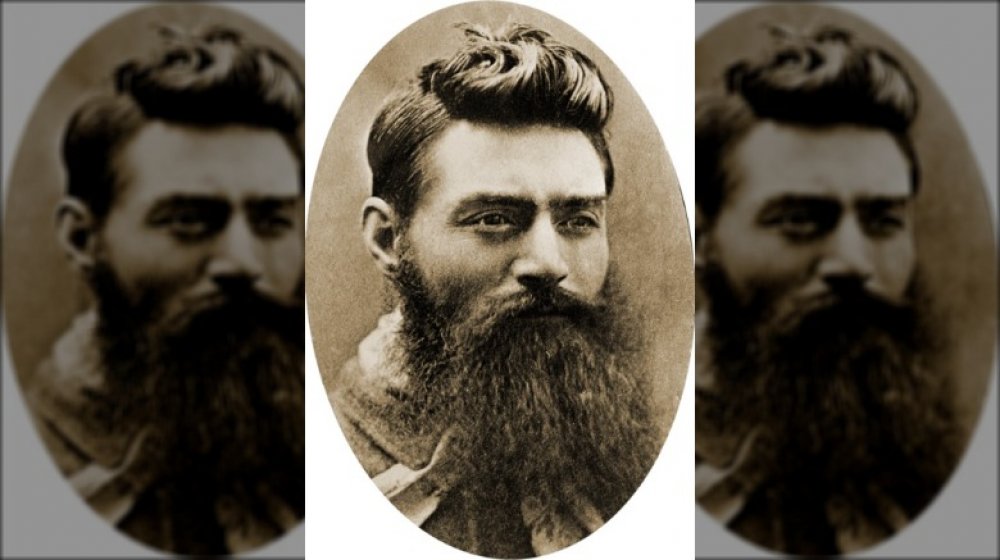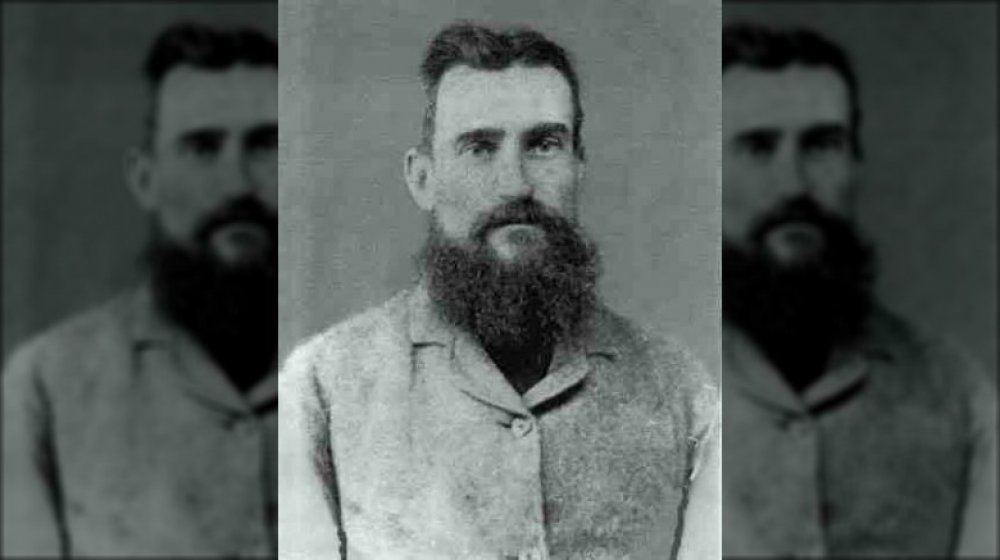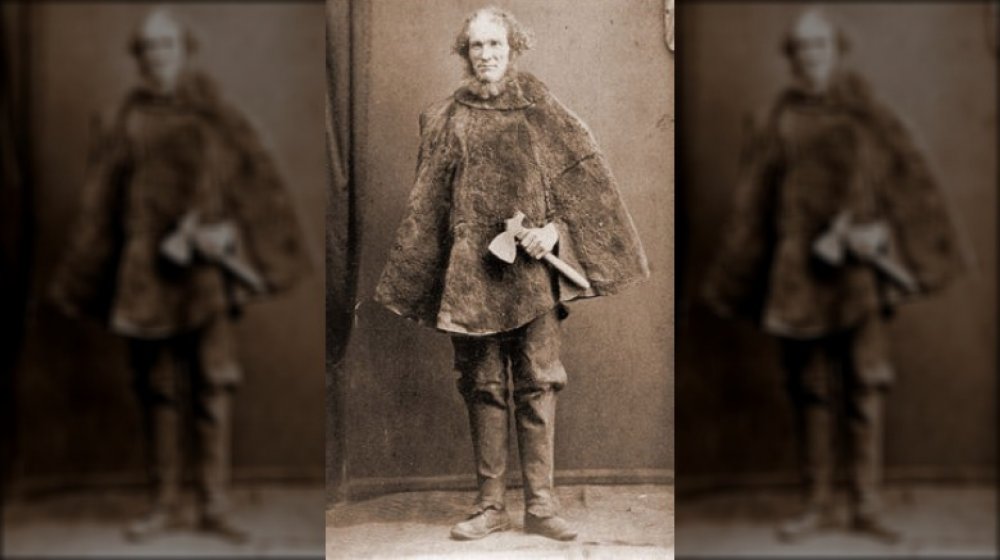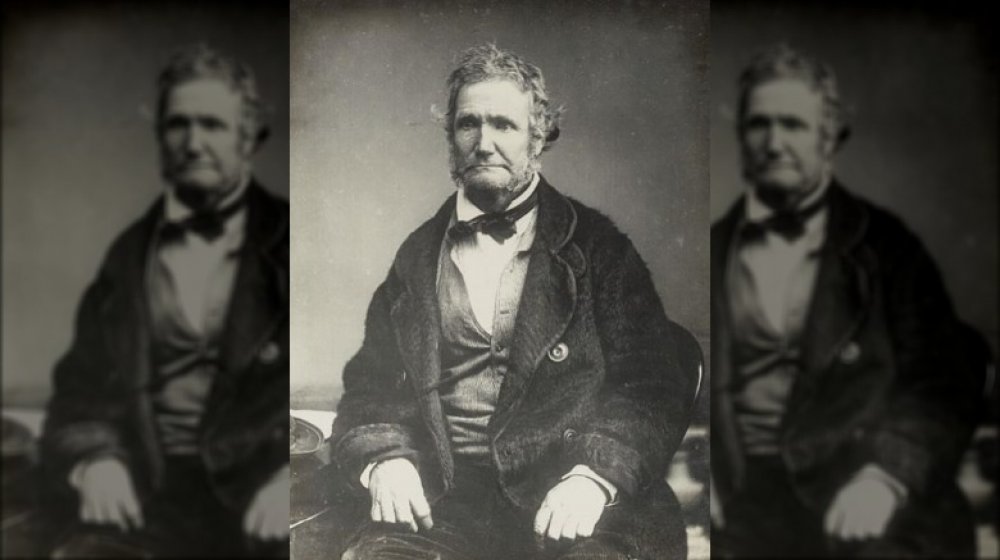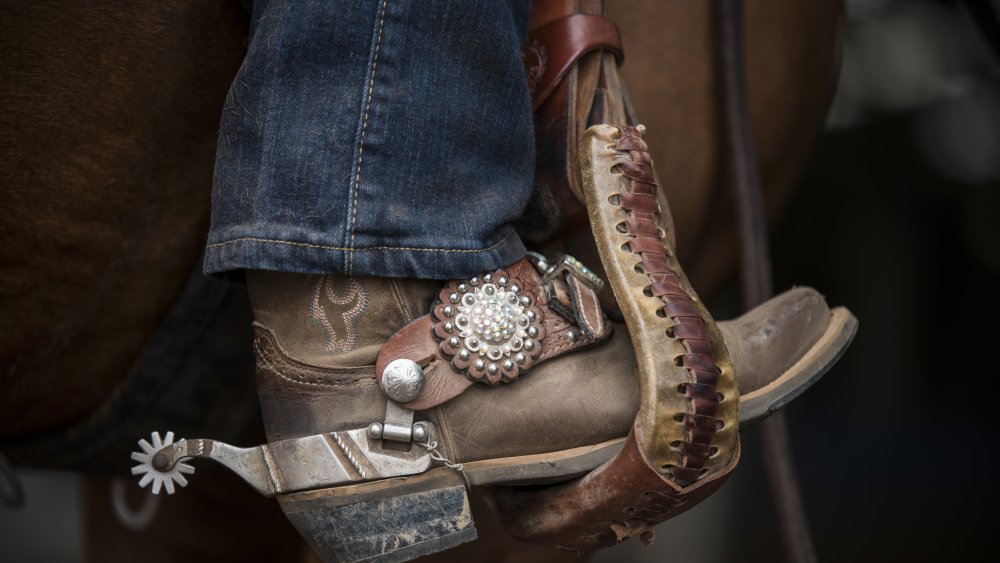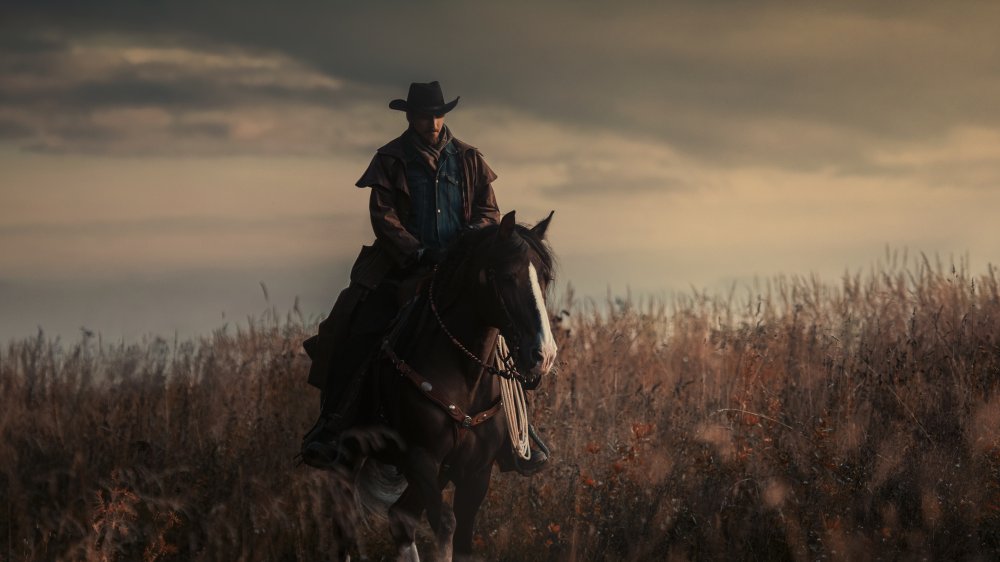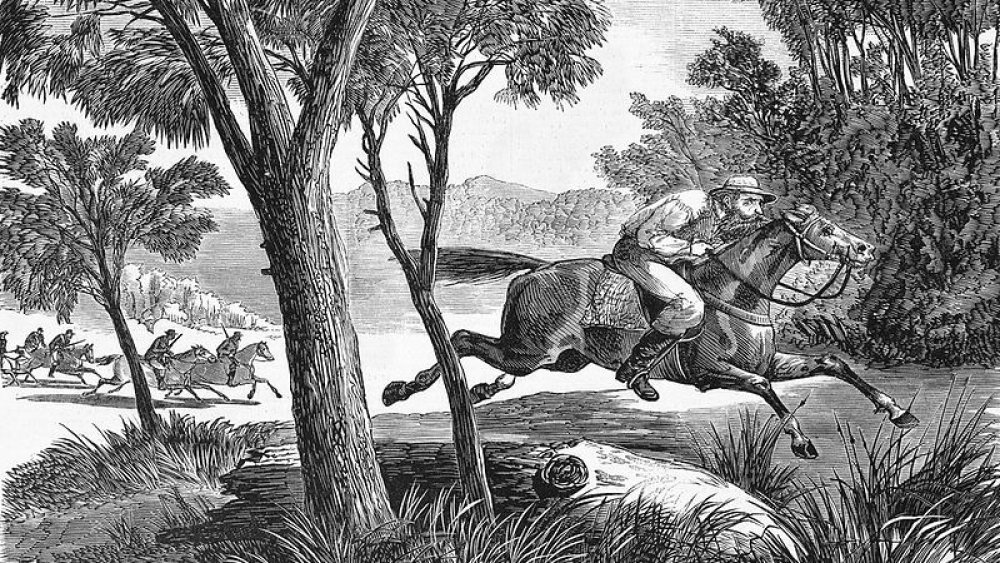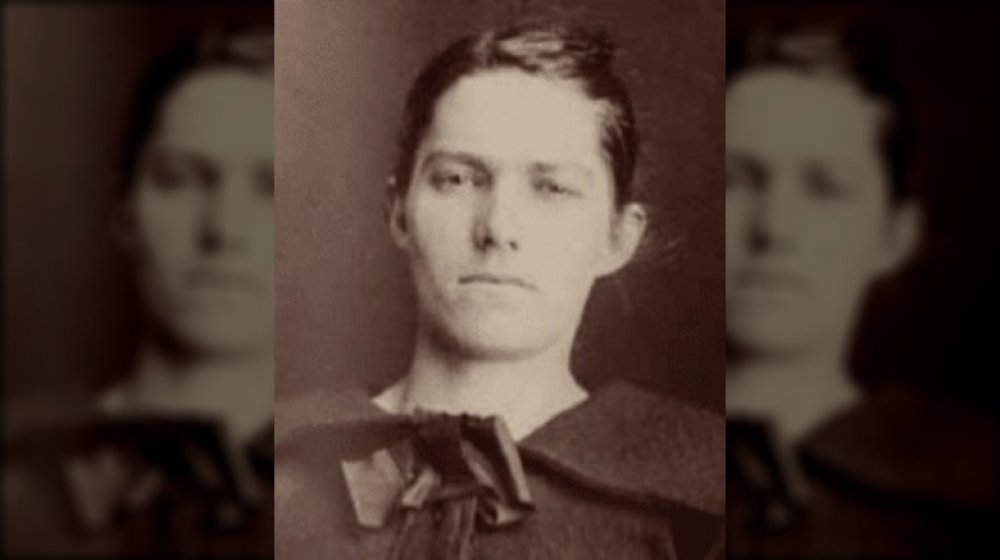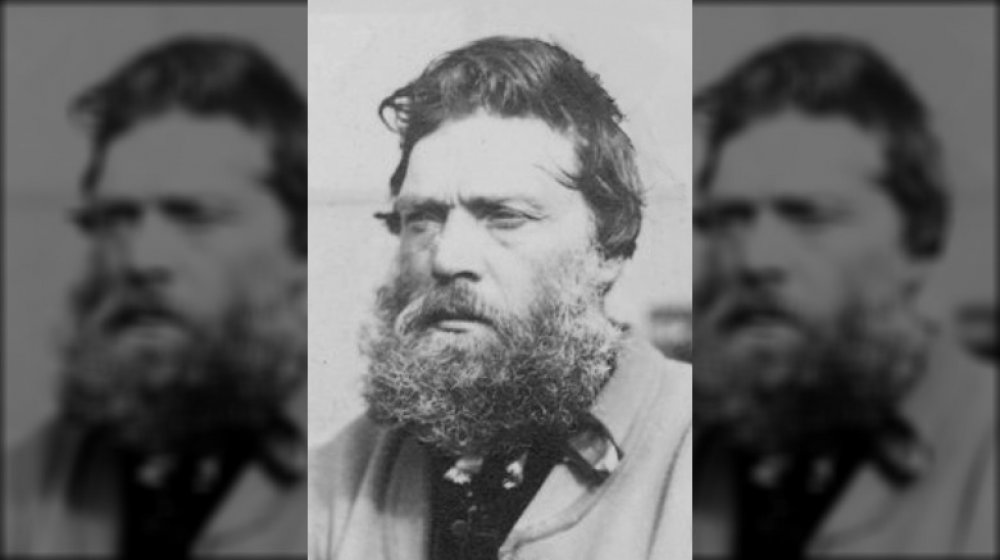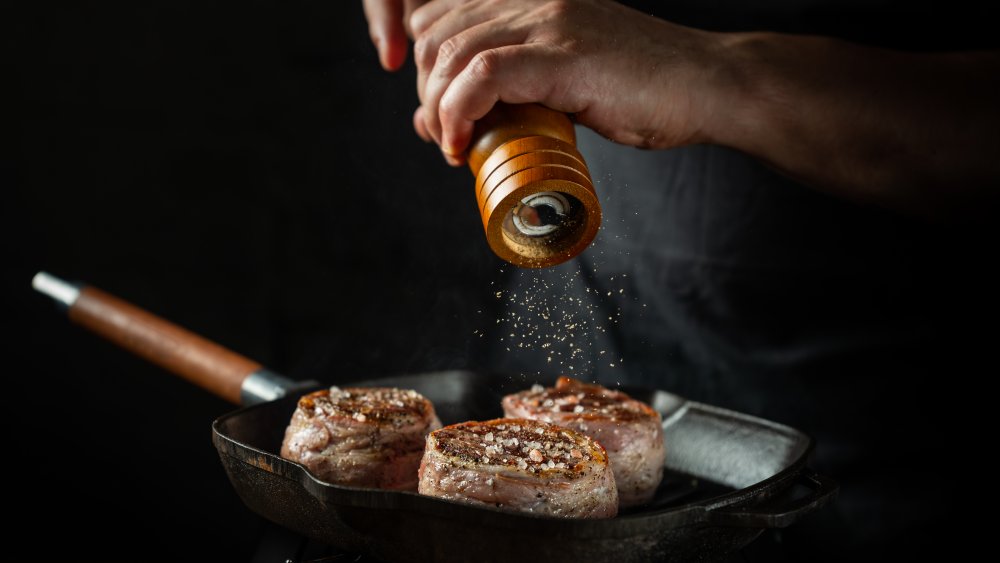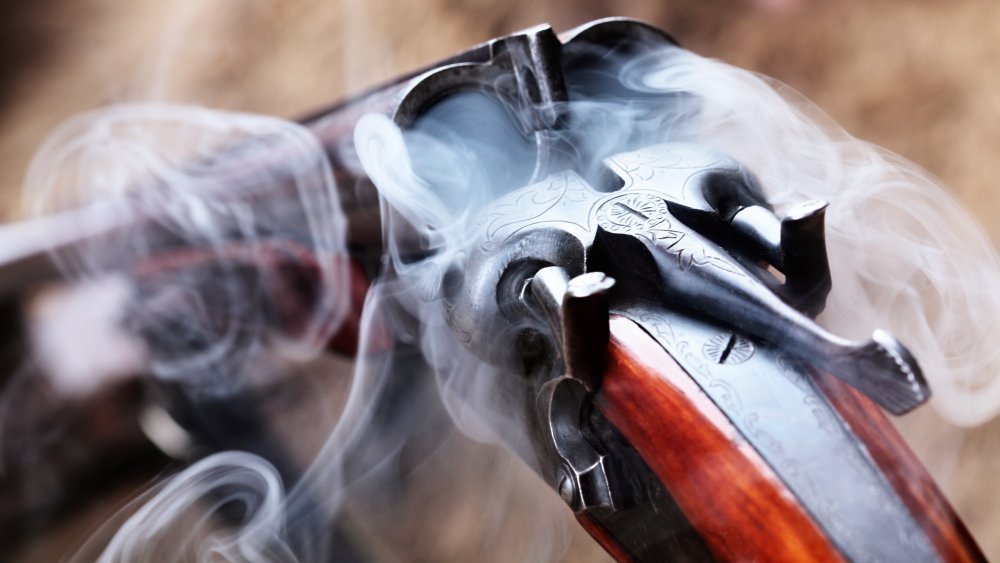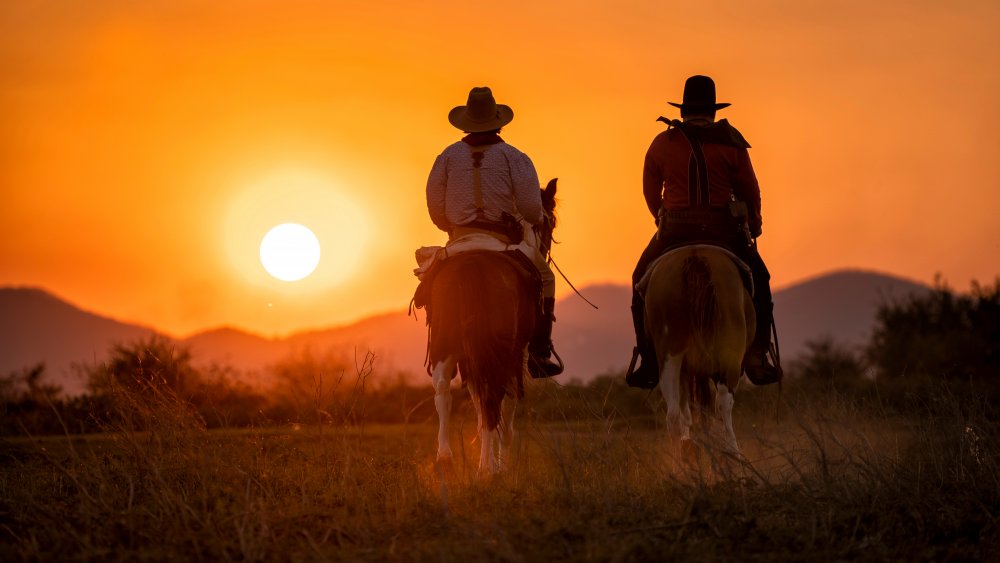The True Tales Of Australia's Most Notorious Bushrangers
History is a strange thing, indeed. Add in a little bit of time and a whole lot of nostalgia, and even the most brutal and bloodthirsty of criminals can become heroes.
That's what happened with a number of Australia's most infamous bushrangers. Sure, they were violent men and women who robbed and killed their way across the Land Down Under, but there's a touch of something else there, too. According to National Geographic, the celebration of the bushranger has something to do with the idea that many were considered not so much criminals but victims themselves.
Many of Australia's greatest outlaws were those who'd fled confinement. Most originally came from England and Ireland, and they found themselves sentenced to years of transportation for minor crimes. Times were tough, life was hard, and people did what they had to in order to feed their families. Sometimes, they got caught. And life in the penal colonies of Australia was brutal, punctuated by hard labor and harder punishments. So some decided to flee and take their chances in the Outback. As a result, they became Australia's wild, notorious bushrangers. Love them or hate them, their stories are absolutely legendary.
Ned Kelly was a bulletproof bushranger
Ned Kelly was one of Ellen Kelly's eight kids, and when his mother took up with James Quinn, there were already suspicions that his step-dad had been stealing horses and cattle.
As for Kelly, the first time he was in serious trouble was on an assault charge — that was in 1869, says the Australian Dictionary of Biography — and even though the charges were dismissed, it was all downhill from there. He was arrested again and again, on charges such as receiving a stolen horse and for being suspected of working with another bushranger, and even though the accusations were all true, Kelly and his clan began to cultivate the belief they were being unfairly targeted.
Part of that may have been correct. When a trooper went to arrest his brother, Dan, in 1878, the officer later claimed that Kelly had shot him — a claim that was never proven. While part of the family was arrested, Kelly and his brother went on the run, and here's where they really did start killing the cops who were chasing them.
What followed was the definition of a spree. They robbed banks, attacked trains, and shot any law enforcement officers who got close to them, all while wearing bulletproof armor made from the pieces of iron ploughs. After a shoot-out in a hotel that left several bystanders dead, Kelly was shot in the legs, captured, and ultimately hanged.
Captain Thunderbolt and Mary Ann Bugg were lovers on the lam
Every good outlaw needs a good name, and Captain Thunderbolt? That's a great name. But when you look at his story as a whole, that's where it gets super interesting. As it turns out, he definitely wasn't working on his own — his wife worked alongside him.
Mary Ann Bugg was the daughter of an Aboriginal woman and a convict (via ABCNews), and at first, her story was pretty normal stuff. But in 1861 — after a few partners and around six kids — she fell in love with a man named Frederick Ward (pictured).
By 1863, Ward had adopted his Captain Thunderbolt persona, and Bugg was right there with him. While he was off robbing, killing, and dodging the police, she acted as a spy and a liaison between him and local Aboriginal people who had no love for the law. She was able to direct Ward's lawless activities, scout potential targets, and provide a place to lie low when it was needed, along with the occasional medical treatment.
There was no "til death do us part" with them, says Inside Story. Thunderbolt was killed in a shootout in 1870 (and according to the State Library of New South Wales, people could view his bullet-ridden body and pick up a postcard), but Bugg had split with him three years earlier. She died in 1905, having had a few more kids, becoming a nurse, and settling down on her own patch of land.
No jail could hold Moondyne Joe
Joseph Bolitho Johns was born somewhere in the UK, and it wasn't until 1848 that his life took a turn toward the criminal. That, says Fremantle Prison's website, is when he was sentenced to transportation for theft. Then in 1861 — after his release — he was arrested for stealing a horse. Again, he served his time, got out, and was quickly arrested for killing an ox — a charge he denied to his last breath.
What followed was something of a comedy of errors. Clearly, "Moondyne" Joe had nothing to lose, so he just started escaping ... again and again and again. His most epic escape came in 1867, when he was sentenced to break rocks in a prison yard. They didn't clear away the rocks he broke, so he used them as cover to chisel his way through the prison wall. He was on the run for two years that time, surviving by stealing chickens and staying in half-way houses (via ADB).
He was something of an anomaly — not violent, regularly law-abiding, and just unlucky. But unfortunately, his story has a sad ending. In 1900, the 70-something ex-con was found wandering in South Perth. He was sent to the Mount Eliza Invalid Depot for care ... and promptly escaped three more times. He died in the Fremantle Lunatic Asylum, and yes, he escaped from there, too.
Martin Cash was the gentleman bushranger
For most who set off on the life of a bushranger, there was no going back. That makes Martin Cash a little different. His story ends in 1877, when he died peacefully in his own bed, succumbing to old age ... about 30 years after he was sentenced to hang.
Cash's foray into the other side of the law started back in Ireland, where he was working as a farm hand when he came across his cheating girlfriend and shot at the other man. It earned him a seven-year transportation sentence, and once his sentence was over, he became involved in a little larceny and grand theft cattle. His career was a long one punctuated by years living in the bush, a few captures, and several escapes, but there was something that made him very different. Unlike many bushrangers, he detested unnecessary violence and mainly targeted rich settlers, earning him the reputation of a "gentleman bushranger."
Things went sideways thanks to another woman, says the Australian Dictionary of Biography. Her name was Bessie Clifford, and when she left him for another man, he decided killing the new suitor would be a bit of necessary violence. So he and an associate headed into Hobart Town, but authorities were waiting. Someone got killed in the chase, and Cash was captured and put on trial. Luckily for him, Cash got a reprieve at the last minute, came out of jail a changed man, and became a hat-maker.
Ben Hall was Australia's most prolific outlaw
Australian-born Ben Hall started out normal enough, working as a stockman for years and marrying the daughter of his employer. But this is where things started to get a little messy.
According to the State Library of New South Wales, it was only a few years into the marriage that his wife hooked up with someone else, and when Hall was out of town, she took their son and left. It was about the same time that his name started popping up in connection with the area's bushrangers, and it wasn't that unlikely a career change. After all, his sister-in-law was the mistress of fellow bushranger Frank Gardiner.
Between 1863 and 1865, Hall and his gang were associated with more than 100 robberies ... but here's the thing. They were almost unconditionally sympathetic to the struggles of the poor and the downtrodden, and they made it a point to target law enforcement. Take their hold-up of one place in Canowindra, New South Wales. At the end of it, they provided food and entertainment for the townsfolk, and they paid the bill of all the travelers staying at the inn. It's no wonder that he had the hearts and support of a lot of the locals, but in the end, it didn't help him outrun the law. He was shot and killed by the cops in 1865.
Edward Davis was an Australian Robin Hood
When Edward Davis was born in England, that most certainly wasn't his name. He was called George Wilkinson when he was sentenced to seven years transportation for trying to steal a till, and once he was in Australia, he decided he would prefer to escape rather than serve that time peacefully. After four escapes, he and a handful of associates assembled a small gang of bushrangers.
But this gang was a little different than most, in that Davis and his guys didn't just steal, they only stole from those who they thought could afford it. They also did quite a bit of Robin Hood-style redistribution of wealth, were always polite to the ladies, and murder was off the table save in extreme circumstances. Perhaps best of all, people always knew when they were coming, as they preferred brightly colored clothes and decorated their horses with pink ribbons.
Alas, all good things have to come to an end, and in 1840, one of the gang members killed a man when they were holding up a general store. Davis — who wasn't even in the store when the killing happened — was still captured and put on trial for aiding and abetting. There was a huge outcry from the public, but Davis' death sentence was still carried out. He was buried in a local Jewish cemetery, and according to the Australian Dictionary of Biography, his strong moral code was ascribed to his equally strong faith.
They called him 'Mad Dog' Morgan for a reason
Dan Morgan — born Jack Fuller — had his first run-in with the law when he was convicted for armed robbery in 1854. When he got out of jail, he didn't just hate law enforcement ... he hated everyone.
While some bushrangers had something of a Robin Hood thing going on, Morgan was all cruelty. The stories are gruesome. The State Library of Victoria tells of one instance where he got wind of an overseer who he felt was getting too comfortable with the police. When Morgan showed up at his home, he wasn't there, but his wife was — so he backed her up against a fire and forced her to stand there while her clothes burned. He threw water on her and put out the flames ... eventually.
Australian Geographic says Mad Dog's name came from his unpredictable and often violent outbursts. Torture was a way of life for him, and he was fond of holding his victims as they died. Sometimes, he could be moved to spare a life. When one woman stood between the bushranger and her husband and begged Morgan to spare him, he did ... after ordering the man to put his hands in the air and then shooting one (via News.com.au).
Morgan was eventually shot and killed during a standoff at a farmhouse, and afterwards, he was beheaded, skinned, and locks of his hair and beard were handed out as mementos.
Jessie Hickman was the Lady Bushranger
Jessie Hickman's story is incredible from day one. When she was eight years old, her parents gave her to a travelling circus. She was fortunate enough to find a father figure in the circus' owner, but when he was killed in an accident, she turned to gambling. From there, it was just a short step into stealing to cover her debts, and it wasn't long before she became a full-fledged bushranger.
After giving away the baby she had in 1913 and serving a few stints in prison, she dove headfirst into the world of cattle rustling. At the time, she officially worked as a housekeeper for a man named John Fitzgerald, and even though she often referred to him as her husband, she also killed him with a broken chair leg after he hit her with said chair.
Her career was shockingly long. By 1928, she had married, divorced, and was driving herds of stolen cattle through some of Australia's most unforgiving terrain. By this time, the female outlaw started attracting men who wanted to ride with her, who she called her "young bucks." According to Vice, she was finally caught in 1928, but when her stolen cattle were stolen from police, she walked free because of a lack of evidence. She died in 1936 of a brain tumor and was buried in a pauper's grave.
Harry Power passed on the craft to the next generation
Harry Power's early years were a pretty typical story, filled with stealing horses and wounding the law enforcement officers who tried to stop him. But after spending several years confined to a prison hulk, he was transferred, escaped, and fell in with a familiar name in Australia's history — Ned Kelly.
Kelly was only 13 years old at the time, and according to the Australian Dictionary of Biography, Power crossed paths with him only briefly. Still, the association was enough to get Kelly arrested, even though the charges were ultimately dropped. Still, according to News.com.au, it was Power's influence that planted the seed of rebellion in the teenage Kelly.
But apparently, Kelly didn't run with Power long enough to see the good side of him, because he was, by most accounts, a decent enough guy. He never resorted to violence unless he needed to, and he was also notorious for another reason: a sense of humor. For example, there's one story where he was set upon by three men. Instead of fighting his way out, he agreed to go with them peacefully. Then, seeing his opportunity, he stole their guns and their clothes and left them to head home naked.
He was ultimately brought to justice thanks to an unlikely informant: Ned Kelly's grandfather. After fans petitioned for his release, he got a job as a tour guide on the ship he'd once been imprisoned on. Within the year, he fell overboard and drowned.
Alexander Pearce was the cannibal bushranger
The Irish-born Alexander Pearce couldn't have known what direction his life would take when he was sentenced to transportation for stealing six pairs of shoes, but be warned, it's dark stuff. According to the NZ Herald, he escaped several times before being sentenced to serve the rest of his time in one of the worst places imaginable: Macquarie Harbor. He soon escaped with seven other men. They spent around 100 days living in the Australian bush, and when law enforcement finally caught their trail, Pearce was the only one left ... and he had a terrible tale to tell.
Eight days into their escape, the hunger became too much. So they killed a fellow escapee named Alexander Dalton because he'd volunteered to administer beatings to the other prisoners. And according to Headstuff, they ate him. Two of the men disappeared overnight, fleeing the scene, but eventually returned ... and died not long after. Technically, it was from "exhaustion." In reality, well, they were probably bruised and battered before they shuffled off this mortal coil.
Pearce would unsurprisingly contradict his own story repeatedly, and just what happened to some of the other convicts isn't known. Pearce did say, though, that finally it came down to himself and a sailor named Robert Greenhill, and Pearce made sure to kill the other guy first. And when he finally made it to Tasmania, he was found eating a man, so there's that. He was returned to Macquarie, escaped again, and when he was recaptured, it was with pieces of flesh in his pockets. Unsurprisingly, he was executed.
John Black Caesar was Australia's very first bushranger
All things have to start somewhere, and the idea of the bushranger started with John Black Caesar.
It's not known just where he originally came from, but according to the Australian Dictionary of Biography, he was from somewhere in Africa, possibly Madagascar. He was working as a servant in England when he was sentenced to transportation with the infamous First Fleet (the ships that founded the Australian penal colonies in 1788), and at first, he was one of the more well-respected convicts in the colony, known for his work ethic. But when he was put on trial again for theft and given a life sentence, he escaped and headed into the bush.
His career was a lot of getting recaptured and escaping again, and along the way, he served some time on Norfolk Island. After being involved in a conflict with local Aboriginal warriors, he fled for the last time and spent about a year living in the bush before he was shot and killed for a reward ... which was five gallons of liquor.
The tale of Captain Moonlite and James Nesbitt is one of love in the Outback
Andrew George Scott went by the name Captain Moonlite, and his story is a little different than that of your typical outlaw. It was only after his death that his personal letters became public, and it put his days as a bushranger in a whole different light.
According to Sydney Living Museums, Scott started out as a bank robber and tried to use the funds to buy a yacht and flee, but he was caught and thrown in jail. It was in Pentridge Prison that he met James Nesbitt, and after they were both released, they did some time on the speaking circuit, preaching about prison reforms. Dogged by the police, things eventually turned violent, and Nesbitt was killed in a shoot-out with the cops. Those who survived were captured, and while he was in jail — awaiting his execution — Scott wrote about his friend.
It was his dying wish that they be buried beside each other, and while Australian Geographic says it's not 100 percent clear just what their relationship was, it does seem to have had an element of romantic love. Scott cried as he held his dying friend, he wore a ring made of Nesbitt's hair, and professed his love in letters. According to The Sydney Morning Herald, his wish to be buried alongside his beloved wasn't granted ... not until 1995, that is, when he was exhumed and reburied.
